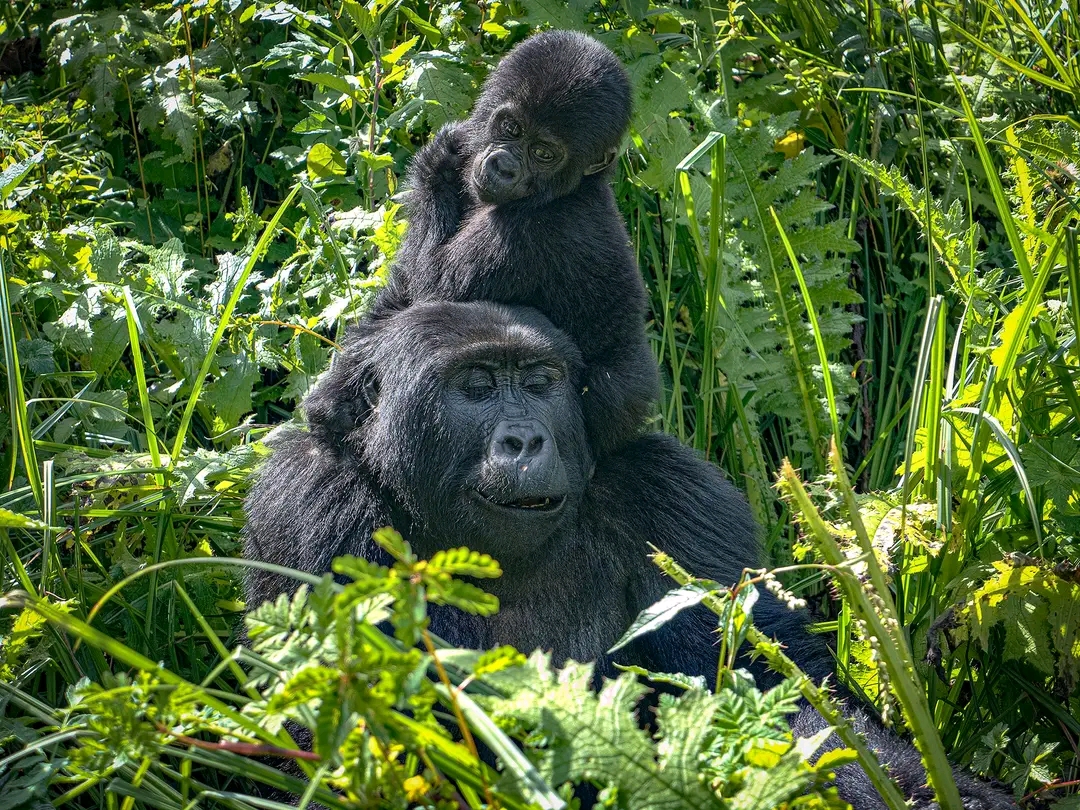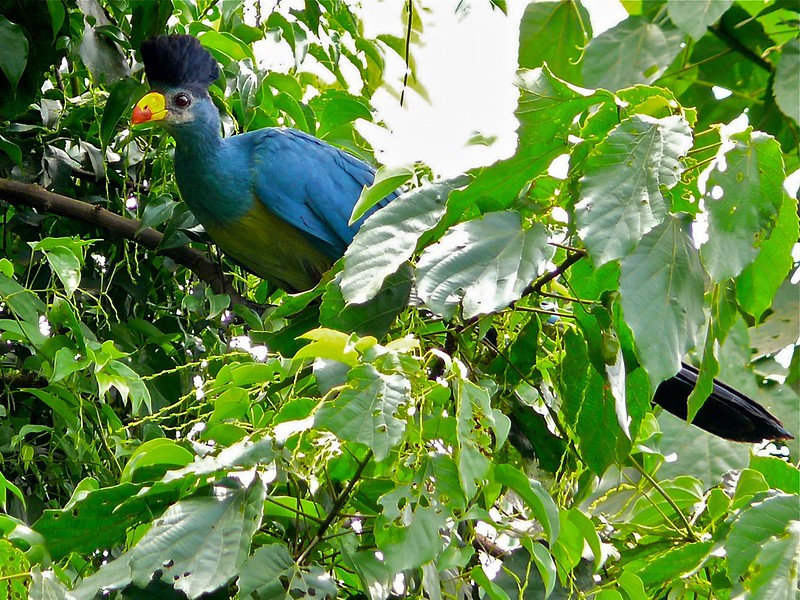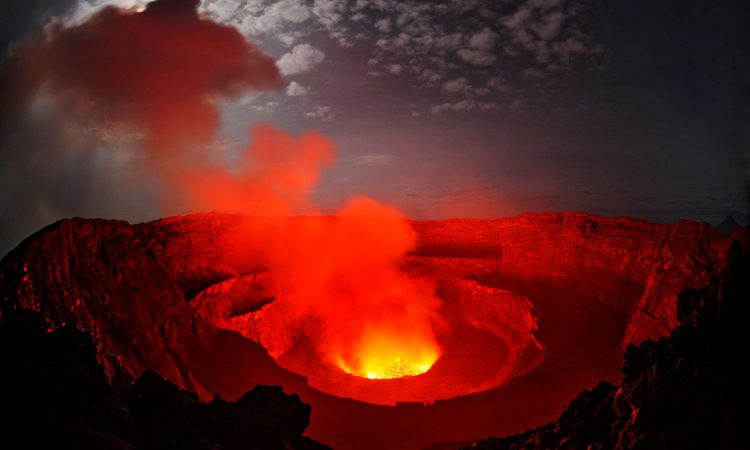Virunga National Park formerly Albert National Park, is located in the Albertine Rift Valley on the eastern edge of the Congo Basin. Congo Basin stands as the world’s second-largest tropical rainforest, and the most bio-diverse protected area. It is home to over one thousand species of mammals, birds, reptiles, and amphibians as well as a third of the world’s endangered mountain gorillas.
Background
Virunga National Park was created in 1925, having an area of 7,900 sq. kms (3,050 sq. miles) and it contains a vast diversity of habitats being known as the park of fire and ice for its diversity ranging from the Rwenzori peaks to savanna and volcanic plains. In 1979, Virunga National Park was listed as a UNESCO World Heritage Site because of its rich diversity of habitats, exceptional biodiversity and endemism, and its protection of the rare mountain gorillas. The park also contains two active volcanoes namely, Mount Nyiragongo and Nyamuragira.
Virunga national park is the oldest wildlife protected area in Africa that was created to preserve and protect the unique wildlife species in the park, for research and protecting the indigenous fruit gathering community.
The natural gifted Virunga national park contains a rich diverse ecosystem with volcanic and block mountains, craters and crater lakes, the Albertine rift, rain forests, woodlands and grasslands, wetlands and swamps among thousands of wildlife. This ecosystem extends to Uganda with the Rwenzori mountains, Semuliki landscapes, Queen Elizabeth National Park, Bwindi Impenetrable National Park and Mgahinga Gorilla National Park. It also continues to Rwanda in the Volcanoes national park. It’s also important to note that the 3 countries (Uganda, D.R Congo and Rwanda) are the only ones that host the endangered mountain gorillas in the whole of Africa.
Unique attractions in Virunga national park
Abundant Wildlife
The wildlife species in the Virunga national park are overwhelming to any visitor who comes, and this makes it a must visit place in DRC. The park has a variety of flora and fauna that attracts a lot of tourists all over the world to come to encounter these beautiful creatures. The park has a vast plant life of about 2077 plant species of which 230 grass species and 264 plant species are endemic in the park. Wetlands and swamps that connect to main water bodies rise to open grasslands, woodlands and rain forests.
Great Apes
Virunga National Park is the only protected area on Earth which is a home to three taxa of great apes the mountain gorilla, eastern lowland gorilla and eastern chimpanzee. Park rangers and staff strive to provide conditions which support the growth of their populations, which are threatened by conflict, habitat loss and poaching, leaving them in danger of extinction.
Mammals
Virunga national park is blessed with overwhelming mammal species that can be seen in one place in big numbers, the park is gifted with over 218 species of mammals of which 22 of them are primates found inside the park, 107 reptile species, 65 amphibians and 706 bird species, all this will make your safari a memorable one. Clients that visit the park have options on seeing these animals for example through game drives, nature walks, hikes, boat rides and tracking primates in their sector. On your visit, hope to see elephants, lions, buffaloes, leopards, hippos, warthogs, okapi, bongo, waterbuck, bushbuck, blue duikers, giant forest hogs, antelopes among many others. The rainforests and the montane forest vegetation are perfect places to spot gorillas, chimpanzees, golden monkeys, red tailed monkeys, central African red colobus, Blue monkeys, Black and White monkeys, Olive baboons, De brazza’s monkey, Hamyn’s monkey, among others.
Climate
The climatic conditions of the Virunga make it a perfect destination for travelers who would love to live with the preserved ecosystem environment. The equator line passes through the Virunga and comes with high temperatures during day and becomes very cold in the night. The soils of the Virunga are fertile and rich with nutrients good for farming and enable rapid plant growth. There is tropical and equatorial climate that supports the ecosystem and makes it possible for animal and plant growth with a variety of water bodies like lake Edward, lake Kivu and Lake Albert.
Others attractions include the birds, volcanic mountains, lakes and wildlife in the park.
Activities done in Virunga national park

Gorilla tracking
Gorilla tracking is the biggest activity done in the park and all the treks to see the gorillas are led by the Virunga Rangers and local pisteurs who are responsible for the daily monitoring of Virunga’s 8 habituated gorilla groups. Treks usually require 2 – 5 hours of hiking each way, depending on location of the group being trekked and the difficulty of the terrain. The trekking begins early in the morning After breakfast where you go for a briefing and begin your trek at Bukima patrol post which is the park’s headquarters. The 8 habitation gorilla families are available for trekking every day and spend a maximum 8 people is allowed to visit them for a maximum of 1 hour in their presence. These gorilla families include Mapuwa Family, Rugendo Family, Lulengo Family, Munyaga Family, Humba Family, Nyakamwe Family, Kabilizi family and Bageni Family which is the biggest among all.
Best time to do gorilla trekking
To safeguard the health of Virunga’s gorillas, visitors will be provided with surgical masks to wear when they are in the presence of these endangered gorillas. As mountain gorillas are susceptible to human illness, all visitors feeling unwell at the time of the scheduled trek are advised to cancel and/or rebook at a time when they are in good condition fit for visiting the gorillas. The age restriction for visiting mountain gorillas is 15 years and above
Chimpanzee tracking
This is another activity done in the park where visitors move into the forests to look for the chimpanzees in their natural habitats. The habituation process is where the chimps are trained by researchers, guides and rangers to be used to the human presence for trekking. During the chimpanzee trekking, you search for these primates and you are only limited to one hour with them and leave their presence. While in the habituation process, you get more time with the chimpanzees to learn about them and their life style in their habitants, you learn about their feeding ways, nesting skills, social life and witness their thinking capacity in the same place.
Chimpanzee habituation process in the democratic republic of Congo, started in 2014 by a Congolese team trained by the Frankfurt Zoologist Society embarked on the journey to habituated the chimpanzee groups living in the Virunga national park with the team of trained people to take part in this activity. Chimpanzee habituation process, takes place in Tongo forest one of the protected areas in Virunga National park with a number of 32 members habituated in this area. These has enabled travelers taking part in chimpanzee trekking to located the chimpanzee easily during the trek in the forest.
Travelers on chimpanzee trekking, are advised to book accommodation closer to the trekking location since the activity starts early morning at 6:00 am with the visit at the park headquarters. During chimpanzee trekking, visitors who are ill or having chronic diseases will not be allowed to trek the chimps to avoid transferring infections to the chimpanzee since they are vulnerable to human infections.
Nature walk in the park
This is another interesting activity that offers one a great opportunity to view the animals on a close range on foot while walking through the safe zones that allow walking safaris. The nature walks begin in the morning and where visitors are led by a ranger guide into the tropical, grassland and woodland forests to visit the Senkwekwe orphanage that inhabits orphan mountain gorillas. While on the nature walk, visitors will be able to have a look at the beautiful landscapes of the park and animals such as elephants, buffaloes, hippos, monkeys, and Nile crocodiles on the banks of lake Edward.
Birding

Birding is yet another beautiful activity done within Virunga national park where visitors wake up to get into the forest to have a birding experience with the help of a birding experienced guide not forgetting a good camera and a pair of binoculars. Virunga national park has a variety of Bird species that include the Rwenzori turaco, Black bishop, African goshawk, Olive Sunbird, Rwenzori batis, Narrow-tailed starling, Madagascar bee-eater, Grey-throated Barbet, Double-toothed Barbet, Yellow-billed Barbet, Red-throated alethe, Stripe breasted tit, White-headed wood hoopoe, Black billed, Great Blue Turaco, Corythaeola cristata, herons, Ibisis, egrets, bitterns, duck, geese, darters, cormorants, skimmers, shoebills, open bills, ospreys, gulls, francolins among many others. Its recorded to have over 706 bird species that inhabit within the thick forest vegetation giving a client a wonderful birding experience.
Nyiragongo volcanic hiking
This is an active volcano in the Virunga national park standing at 3470m high above sea level. Nyiragongo has a beautiful vegetation and snow that features the world’s largest lava lake. The hike takes about 7 hours and it doesn’t require a lot of physical fitness to hike because it is favorable to all people who would like to hike to the peak. As your hiking to the peak, you will be able to see a number of animals like the monkeys, chimpanzees, bush babies among others.

When you reach the peak, you will be able to see a beautiful landscape of the surrounding area and vegetation. When hiking you are required to carry the necessary equipment for your stay up in the hills because there are no built structures, there are camping tents with mattresses and you are supposed to carry your camping gear and other items like medicines, comfortable hiking shoes and gloves, enough drinking water and heavy clothes for the night time when it’s very cold. At the campsite, you will meet a chef who will prepare you coffee to keep you warm at the camp fire plus dinner.
Senkwekwe orphanage center
Senkwekwe Mountain Gorilla Orphanage Center is at the headquarters of Virunga National Park near Mikeno lodge. The center gets its name after the great silverback gorilla “Senkwekwe”. He was a leader of the gorilla group Rugendo during a great massacre of some members in 2007 by rebels. The idea of the gorilla orphanage center came up when two orphaned gorillas (Ndakasi and Ndezi) who survived the massacre were rescued and there was no suitable place to take proper care of them. A decision was made to set up a center to cater for young mountain gorillas that have lost their parents due to poaching, animal trafficking or fighting between government forces and rebels in the park area. The Senkwekwe center was opened in 2010 and has become known as the only place in the world were mountain gorillas have lived successful in captivity.
There are over 6 orphaned mountain gorillas that have lived at the center since its opening in 2010 and they stay in the orphanage throughout the remainder of their life and form a new group of their own in the orphanage. One reason why the gorillas can’t rejoin their old families is that they get too used to being with humans, the privileges and the comfortable life in the enclosure. They would find it difficult to find food on their own without the caregivers at the sanctuary.
Virunga National Park
Under the leadership of Andre Bauma and the management of Virunga National Park, the Orphanage offers a rare opportunity for primate lovers. They contribute directly to a worthwhile conservation effort while also observing mountain gorillas interact closely with humans. The Gorilla Doctors and caretaker staff at the center help protect and raise the orphans. These Gorilla Doctors are a team of veterinary doctors working on several Gorilla conservation projects in Africa among which include treating mountain gorillas in the wild.

About Mountain Gorillas
The forest sanctuary is offering a safe and secure environment for these gorillas to reside and stay in good care. Their are experts and care takers who are very passionate about their livelihood and protect them from extinction. Their daily routine starts with waking up at 6 am, begin playing and receive their breakfast. After breakfast, they are let out into the garden where they feed on the shrubs and spend most of the day. Later in the evening at around 4 pm, they return to the enclosure for supplementary feeding and dinner served at 5 pm.
Senkwekwe Center also helps in rehabilitating young Grauer’s gorilla (Eastern lowland gorillas) by removing them away from traffickers. They treat them for a given period and then transferring them to the Gorilla Rehabilitation and Conservation Education center (GRACE) for orphaned lowland gorillas. The Senkwekwe mountain gorilla sanctuary has also earned praise for its community outreach and educational activities.
Landscape viewing
Virunga national park has a variety of beautiful and eye-catching landscapes that are worth a visit, beginning with the Nyiragongo volcano, the Rwenzori mountains, rift valleys, craters, rainforests, savannah grassland and woodland among many others. This makes the park a perfect destination for photography and sightseeing.
![]()
Accommodation facilities in Virunga national park
The park has a number of establishments inside and outside, to offer you a comfortable stay while going for your gorilla safari. These range from luxury, mid-range as well as budget lodges/ hotels. One has to make booking for these accommodation facilities on time so that you have ease when you reach the park.
Some of the facilities include;
- Ngila lodge Virunga
- Coco lodge
- Lulimbi tented camp
- Orchids safari club
- Mikone lodge
- Mount Nyiragongo summit shelter
- Kibumba tented camp
- Butima tented camp, among many others
Best time to visit
The park is open to visits throughout the year but the most popular time to travel to the Visit Virunga National Park (Democratic Republic of Congo) is during the months of July through to September and by far the driest months of the year.
How to reach Virunga national park?
You can reach the park by both road and air. By road, you will have to consider flying to Kigali international airport and connect to Gisenyi town by road, then cross to the DRC to Goma town by a dirt road. From Gisenyi town you drive about 2 hours to the park headquarters at Bukima.
Other travelers from Uganda can reach Virunga national park through the Bunagana boarder point in Kisoro district, then drive for an hour to the park headquarters at Bukima.
The park organizes private transport for travelers who arrive at Goma airport by air, to the national park.
Plan for your Gorilla safari
When planning a gorilla safari, consider going through a tour company/ operator to do the parking and managing the safari. If you have plans of traveling to any East African country, choose Pamoja Tours and Travel.







